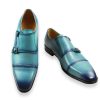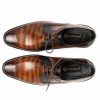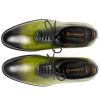The fast fashion industry discards 92 million tons of footwear annually – enough to fill London’s Shard skyscraper 1,500 times over. Amid this waste crisis, a quiet revolution unfolds in artisan workshops where shoemakers stitch sustainability into every seam. Handcrafted footwear isn’t just a luxury; it’s an antidote to disposable culture.
The Material Truth: Turning Waste into Worth
Leather’s Hidden Ecological Story
Byproduct Utilization: 99% of luxury shoemaking leather comes from hides otherwise destined for landfills. Cattle raised for meat produce 290 million hides yearly – artisanal makers salvage this “waste” resource.
Biodegradability: Vegetable-tanned leather decomposes in 50 years vs. synthetic alternatives’ 1,000+ year lifespan, which shed microplastics poisoning oceans. Tuscan tanneries like Conceria Walpier use chestnut bark tannins, creating toxin-free leather that ages like wine.
Natural Material Advantages
Material Handcrafted Use Fast Fashion Equivalent Soles Natural rubber/cork Petrochemical PVC Thread Waxed linen/cotton Plastic nylon Adhesives Water-based resins Cyanide-containing glues The Longevity Equation: Decades vs. Months
Lifecycle Analysis Reveals Shocking Disparities
Cambridge University’s 2023 study compared footwear sustainability markers:
Handcrafted:
Average lifespan: 22 years (with resoling)
CO2 emissions/year: 0.9 kg
Waste generated: 0.3 kg
Mass-produced:
Average lifespan: 18 months
CO2 emissions/year: 4.7 kg
Waste generated: 3.1 kg
Artisan workshops like Spain’s Gabarain consume 83% less energy than factories, using natural light and hand tools. Their welted construction allows 5+ resoles, embodying the “Buy Less, Buy Better” ethos.
Ethics Woven Into Every Stitch
The Human Dimension of Sustainability
Cultural Preservation: In Northampton, England – the epicenter of bespoke shoemaking since 1650 – workshops like Crockett & Jones train apprentices in techniques unchanged for centuries. Each master artisan supports 3-5 local families.
Fair Labor Transparency: Blockchain-enabled traceability (pioneered by brands like Ostmo) lets consumers scan QR codes to see:
Leather origin (e.g., Gold-rated LWG Italian farm)
Tanner’s certification
Artisan wage percentages
Contrast with Fast Fashion:
“While major brands pay $0.23/hour for factory labor (Clean Clothes Campaign 2024), handcrafted shoemakers earn living wages – $18-$42/hour in EU workshops.”
Your Action Plan: The Conscious Consumer’s Guide
Interrogate Brands:
“Where is your leather tanned?” (Seek vegetable-tanned)
“Can I see your workshop?” (Ethical makers welcome visits)
“What’s your resoling policy?” (Lifetime repair = true sustainability)
Decode Certifications:
Leather Working Group Gold: Low-water, chromium-free tanning
Fair Trade Leather: No child labor, living wages
Cradle to Cradle: Circular design certification
Embrace Imperfection:
Natural leather variations (scars, grain patterns) prove authenticity – reject plastic “perfection”
Conclusion: More Than Shoes – A Manifesto
Choosing handcrafted footwear votes for a world where:
Waste becomes heirloom
Labor regains dignity
Shopping becomes stewardship
As Florentine master shoemaker Roberto Ugolini reminds us: “When you buy handmade, you don’t own shoes – you adopt a legacy.” In an age of climate anxiety, that legacy offers hope: sustainability stitched one conscious step at a time.
Footnotes:
Data Sources: UNEP 2024 Textile Waste Report, Leather Working Group, Cambridge Circular Footwear Study
Ethical Brands Showcasing This Model: Septième Largeur (France), Carlos Santos (Portugal), Hiro Yanagimachi (Japan)
0












